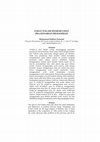Other by Mohammad Zamzami

Al-Qur`an dan Hadits sering menyinggung persoalan persamaan dan perbedaan ritual antara Islam den... more Al-Qur`an dan Hadits sering menyinggung persoalan persamaan dan perbedaan ritual antara Islam dengan Kristen dan Yahudi yang sama-sama sebagai agama sah Ibrahim. Salah satu persamaan ritual tersebut adalah kewajiban mengeluarkan zakat. Dalam tulisan ini, penulis mengkaji persoalan zakat dalam syarî'ah terdahulu dengan menggunakan metode tafsir tematik. Dalam kaitan ini, al-Qur`an menampilkan kata zakah dalam tiga gaya bahasa (uslûb). Pertama, menggunakan uslûb insyâ'iy, yaitu berupa perintah, dengan menggunakan kata âtû, anfiqû, dan khuzh. Kedua, menggunakan uslûb targhîb (motivatif). Ketiga, menggunakan uslûb tarhîb (intimidasi). Keempat, menggunakan uslûb madh (pujian). Karena fokus penelitian ini hanya menyangkut ayat-ayat pokok tentang zakat terdahulu, maka hanya kata-kata dalam ayat pokok itu yang dianalisis berdasarkan tiga gaya bahasa (uslûb) ini. Dalam surat Maryam ayat 31, al-Qur`an menggunakan kata awshâ, dalam surat Maryam ayat 55, al-Qur`an menggunakan kata ya'muru, dalam surat al-Anbiyâ' ayat 73, al-Qur`an menggunakan gabungan kata awhâ dan îtâ', dalam surat al-Baqarah ayat 83, al-Qur`an menggunakan kata âtû, dalam surat al-Mâ'idah ayat 12, al-Qur`an menggunakan gabungan kata umirû dan âtaytum. Dalam keenam ayat di atas, al-Qur`an sama-sama menggunakan gaya bahasa perintah (uslûb insyâ'î). Ini bisa dibuktikan dengan konsekuensi serius bagi pengingkar zakat.
Papers by Mohammad Zamzami

Harmoni
This article attempts to reveal the tradition of marriage in the month of Shawwal in Pamekasan Su... more This article attempts to reveal the tradition of marriage in the month of Shawwal in Pamekasan Sub-district of Pamekasan Madura Regency from 2013 to 2017 in terms of the procedures. This article is the result of field research using phenomenology and living hadith approach. This research succeeded in revealing that the tradition of marriage in the month of Shawwal is one of Madurese wedding forms which has been going on downhill and deeply rooted in a society whose way of determining and the view of its existence varies so it is not realized as one of the socio-religious practices that is actually influenced by Islamic marriage tradition whose existence is derived from the hadith of the Prophet. Abstrak Artikel ini berusaha mengungkap tradisi pernikahan pada bulan Syawal di Kecamatan Pamekasan Kabupaten Pamekasan Madura sejak tahun 2013 hingga tahun 2017 dari segi tata caranya. Artikel ini merupakan hasil penelitian lapangan yang menggunakan pendekatan fenomenologi dan living hadit...

Randomized controlled evaluation shows the effectiveness of a home-based cardiac rehabilitation program
Saudi Medical Journal, Feb 1, 2012
To evaluate the effectiveness of a home-based cardiac rehabilitation (CR) program on post-coronar... more To evaluate the effectiveness of a home-based cardiac rehabilitation (CR) program on post-coronary arteries bypass graft patients. This is a randomized study conducted in King Fahd Armed Forces Hospital, Jeddah, Kingdom of Saudi Arabia between June 2008 and January 2010. Forty-nine participants were randomized to either a control group (standard hospital treatment, n=21) or an intervention group (home-based CR, n=28). Data were collected before hospital discharge (baseline test) and repeated 6 months after hospital discharge (follow-up test). There were no significant differences between the groups in the body mass index, hemodynamics, serum fasting lipid profile, and Quality of Life questionnaire (QoL) (p>0.05), with differences in physical function and Hospital Anxiety and Depression Scales (HADS) (p<0.05) at the baseline test. At the follow-up test, the intervention group showed greater improvement in health-related QoL and risk factors compared to the control group, with significant differences in fasting blood glucose, triglycerides, high density lipoprotein cholesterol, physical function, and both QoL and HADS questionnaires (p<0.05). The intervention group also demonstrated significant improvements in QoL, HADS, body mass index, heart rate, high density lipoprotein cholesterol and physical function (p<0.05), while significant differences were observed in the control group in heart rate, QoL and physical function (p<0.05). The home-based CR program improves health-related QoL and risk factor profiles for patients following coronary arteries bypass graft to greater extent than the standard hospital care.

Randomized controlled evaluation shows the effectiveness of a home-based cardiac rehabilitation program
Saudi medical journal, 2012
To evaluate the effectiveness of a home-based cardiac rehabilitation (CR) program on post-coronar... more To evaluate the effectiveness of a home-based cardiac rehabilitation (CR) program on post-coronary arteries bypass graft patients. This is a randomized study conducted in King Fahd Armed Forces Hospital, Jeddah, Kingdom of Saudi Arabia between June 2008 and January 2010. Forty-nine participants were randomized to either a control group (standard hospital treatment, n=21) or an intervention group (home-based CR, n=28). Data were collected before hospital discharge (baseline test) and repeated 6 months after hospital discharge (follow-up test). There were no significant differences between the groups in the body mass index, hemodynamics, serum fasting lipid profile, and Quality of Life questionnaire (QoL) (p>0.05), with differences in physical function and Hospital Anxiety and Depression Scales (HADS) (p<0.05) at the baseline test. At the follow-up test, the intervention group showed greater improvement in health-related QoL and risk factors compared to the control group, with s...

A controlled trial of home-based cardiac rehabilitation versus usual hospital care in cardiac patients
Journal of the Saudi Heart Association, 2012
ABSTRACT Objective This study aimed to evaluate the effect of a home-based cardiac rehabilitation... more ABSTRACT Objective This study aimed to evaluate the effect of a home-based cardiac rehabilitation (CR) program combining a home-based exercise training program with phone calls counselling educational talks and group workshops on surgery, risk factors, recovery, healthy lifestyle and physical activities on post-bypass patients. Method Forty-nine participants were randomized to either a control group (standard hospital, n = 21) or an intervention group (home-based CR, n = 28) in King Fahd Armed Forces Hospital, Jeddah. Data were collected before hospital discharge (baseline test) and repeated 6 months after hospital discharge (follow-up test). Results No significant differences between the groups in body mass index (p = 0.691), hemodynamics (p &gt; 0.05), the serum fasting lipid profile (p &gt; 0.05) and Quality of Life questionnaire (QoL) (p = 0.358), with differences in physical function (p = 0.000) and Hospital Anxiety and Depression Scales (HADS) (p &lt; 0.05) at the baseline test. At the follow-up test, the intervention group showed greater improvement in health-related QoL and risk factors compared to the control group, with significant differences in fasting blood glucose (p = 0.000), triglycerides (p = 0.033), high density lipoprotein cholesterol (p = 0.005), physical function (p = 0.000) and QoL and HADS questionnaires (p = 0.000). The intervention group also demonstrated significant improvements in QoL (p = 0.000), HADS (p &lt; 0.05), body mass index (p = 0.000), heart rate (p = 0.001), high density lipoprotein cholesterol (p = 0.032) and physical function (p = 0.000), while significant differences were observed in the control group in heart rate (p = 0.011), QoL (p = 0.000) and physical function (p = 0.000) between baseline and follow-up tests. Conclusion The home-based CR program improves health-related QoL and risk factor profiles for patients following CABG to greater extent than standard hospital care.

Effects of an 8-week resistant training programme on quality of life and physical activity
Journal of the Saudi Heart Association, 2012
ABSTRACT Objectives Quality of Life (QoL) following a Coronary Artery Bypass Graft (CABG), have b... more ABSTRACT Objectives Quality of Life (QoL) following a Coronary Artery Bypass Graft (CABG), have been found to predict subsequent morbidity and mortality, independent of known prognostic factors, whereas other studies reported that a substantial proportion of post-CABG patients who did not receive a proper recovery experienced either no improvement or less improvement in QoL after hospital discharge. The aim of this study was to assess the effects of 2-month Cardiac Rehabilitation (CR) programme on post-CABG patients’ health-related QoL, physical activity and hemodynamics profile. Materials and methods Forty patients who underwent cardiac surgery have been divided to either a CR group (n = 20) who followed a phase VI a supervised resistant training programme twice a week for 2 months at hospital or a control group (n = 20) who followed a usual standard hospital care. The outcome measures were a 6-min Walking Test (6-MWT), 36-Item Short Form Survey (36-SF), resting HR, SBP and DBP. Results At the end of the study period, there was no significant difference in resting SBP (p = 0.119) between both groups. However, the CR groups showed significant differences in the 6-MWT distance (p = 0.000), resting HR (p = 0.034) and DBP (p = 0.005) compared to the standard hospital care group. In addition, patient satisfaction in the CR groups, as measured in the survey, held a significant improvement in overall QoL (p = 0.000) compared to the standard hospital care group. Conclusions This study observed a complete disappearance of symptoms and sign of improvements in the heart beats, SBP and DBP after resistance training. This type of CR using a moderate intensity exercise programme proved to improve QoL, physical activities and worth implementing in selected categories of patients.









Uploads
Other by Mohammad Zamzami
Papers by Mohammad Zamzami